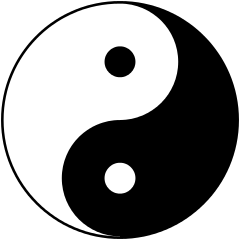The OP describes exhaustive and mutually exclusive cases, with two options or outcomes. In statistics, this segmentation of the possible outcomes in a finite number of choices is often called a categorical variable. When the variable only takes two values, it is generally termed:
- dichotomous variables (which was first proposed by @plagueheart, and I did not see it at the time of my answer), from Greek dikhótomos, “cut in half” or "cut in two".
or
- binary (already proposed by @Malvolio), for "appearing in pairs" (not directly related to the binary or base-2 number system) or Bernoulli variables. The related categories are often denoted by values 0 and 1 (very "binary" in the logical or computer sense), or 1 and 2.
Sometimes, categorical variables are segmented into: nominal, ordinal or dichotomous. Sometimes, people use "categorical variables" only for cases of three or more possible outcomes (multi-way, n-ary or polytomous), as opposed to 2-ary case.
Binary and dichotomous are sometimes considered synonyms. They both contains the root 2 (di- or bi-). For some, binary variables form a sub-species of dichotomous variables, whose values are assigned either a 0 or 1 label or binary state. The suffix -tomy ("to cut", like in atom, with privative "a-", which cannot be cut) in dichotomy seems more precise than the concept of arity, that denotes two objects or operands ("binary stars", "binary operation"), without clear reference to the mutual exclusion.
With 0 or 1 binary labels, it remains possible to perform mathematical operations on variables (like averaging) and to quantize or dichotomize the result afterward, while it is more difficult to "average" red and not-red dichotomous categories.
[EDIT] After some comments, one can wonder about the correct use of "binary" vs "dichotomous", the latter being at first glance the correct one. However, the use of binary is widespread. I tend to consider "binary" as a metonymy for the dichotomous case, as illustrated in the Yin-Yang symbol:

There are two categories: the shady side (yin), and the non-shady or sunny side (yang). They are mutually exclusive (although intricated and dual). But one could describe them has black and white, with colors represented by 0 and 1. In other words, labels 0 and 1 somehow encode the two possible outcomes, and the 0 and 1 symbols inherit from the mutually exclusive nature of the binary numbers.
Additional details are provided in What is the difference between “dichotomous”, “binary”, “boolean”, etc.?

